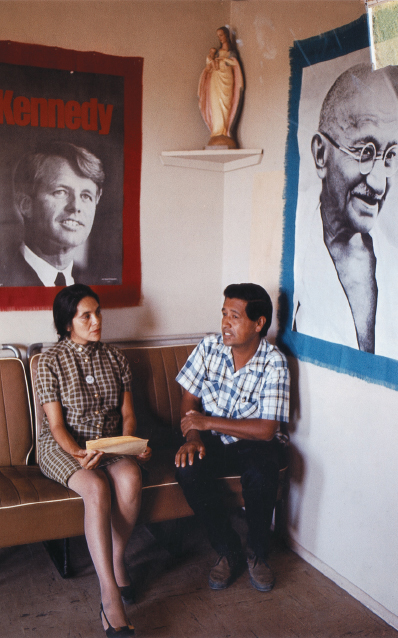Latino Struggles for Justice
Printed Page 852
The fastest-growing minority group in the 1960s was Latino, or Hispanic American, an extraordinarily varied population encompassing people of Mexican, Puerto Rican, Caribbean, and other Latin American origins. (The term Latino stresses their common bonds as a minority group in the United States. The older, less political term Hispanic also includes people with origins in Spain.) People of Puerto Rican and Caribbean descent populated East Coast cities, but more than half of the nation’s Latino population — including some six million Mexican Americans — lived in the Southwest. In addition, thousands illegally crossed the border between Mexico and the United States yearly in search of economic opportunity.
CHAPTER LOCATOR
What liberal reforms were advanced during the Kennedy and Johnson administrations?
How did the civil rights movement evolve in the 1960s?
What other rights movements emerged in the 1960s?
What were the goals of the new wave of feminism?
How did liberalism fare under President Nixon?
Conclusion: What were the achievements and limitations of liberalism?
 LearningCurve
LearningCurve
Check what you know.
Political organization of Mexican Americans dated back to the League of United Latin American Citizens (LULAC), founded in 1929, which fought segregation and discrimination through litigation (see "The Great Migrations of African Americans and Mexicans" in chapter 22). In the 1960s, however, young Mexican Americans increasingly rejected traditional politics in favor of direct action. One symbol of this generational challenge was young activists’ adoption of the term Chicano (from mejicano, the Spanish word for “Mexican”).
The Chicano movement drew national attention to California, where Cesar Chavez and Dolores Huerta organized a movement to improve the wretched conditions of migrant agricultural workers. As the child of migrant farmworkers, Chavez lived in soggy tents, changed schools frequently, and encountered indifference and discrimination. One teacher, he recalled, “hung a sign on me that said, ‘I am a clown, I speak Spanish.’” After serving in World War II, Chavez began to organize voter registration drives among Mexican Americans.
 Mobilization of Mexican Americans in the 1960s and 1970s to fight for civil rights, economic justice, and political power and to combat police brutality. Most notably, the movement worked to improve the lives of migrant farmworkers and to end discrimination in employment and education.
Mobilization of Mexican Americans in the 1960s and 1970s to fight for civil rights, economic justice, and political power and to combat police brutality. Most notably, the movement worked to improve the lives of migrant farmworkers and to end discrimination in employment and education.

In contrast to Chavez, Dolores Huerta grew up in an integrated urban neighborhood and avoided the farmworkers’ grinding poverty but witnessed subtle forms of discrimination. Once, a high school teacher challenged her authorship of an essay because it was so well written. Believing that collective action was the key to progress, she and Chavez founded the United Farm Workers (UFW) in 1962. To gain leverage for striking workers, the UFW mounted a nationwide boycott of California grapes, winning support from millions of Americans and gaining a wage increase for the workers in 1970. Although the UFW struggled and lost membership during the 1970s, it helped politicize Mexican Americans and improve farmworkers’ lives.
Other Chicanos pressed the Equal Employment Opportunity Commission (EEOC) to act against job discrimination against Mexican Americans. After LULAC, the American GI Forum, and other groups picketed government offices, President Johnson responded in 1967 by appointing Vicente T. Ximenes as the first Mexican American EEOC commissioner and created a special committee on Mexican American issues.
Claiming “brown power,” Chicanos organized to end discrimination in education, gain political power, and combat police brutality. In Denver, Rodolfo “Corky” Gonzales set up “freedom schools” where Chicano children learned Spanish and Mexican American history. The nationalist strains of Chicano protest were evident in La Raza Unida (the United Race), a political party founded in 1970 based on cultural pride and brotherhood. Along with blacks and Native Americans, Chicanos continued to be disproportionately impoverished, but they gradually won more political offices, more effective enforcement of antidiscrimination legislation, and greater respect for their culture.